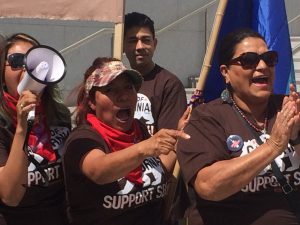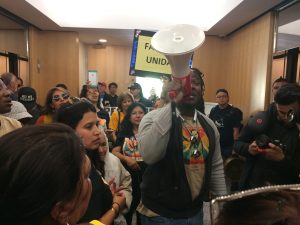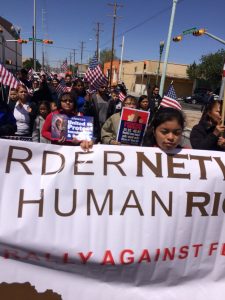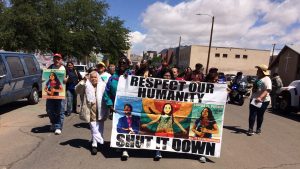 How are Donald Trump’s anti-immigrant measures affecting migrant communities living on the border? What are they doing to defend themselves?
How are Donald Trump’s anti-immigrant measures affecting migrant communities living on the border? What are they doing to defend themselves?
The Caravan Against Fear set out to answer these questions on April 10. Leaving out of Sacramento, eight white vans carried some fifty people, most strangers until the trip, tracing the border from California to Texas and back again. The caravaners came from the U.S. Southwest and Mexico, including Central American migrants living in the U.S. they were workers, communicators, organizers and union reps. Women janitors of the Service Employees International Union (SEIU) made up the largest group. The SEIU co-organized the caravan to take the pulse of border communities, encourage collective responses to fear, and prepare for the May Day mobilization in Los Angeles and across the country.
From the launch until the end, in Los Angeles at the May 1st march, we traveled twenty-one days, more than 5,000 miles and shared hundreds of slogans, songs, speeches and laughs. It’s impossible to sum up the experience in a few words. Here, instead, are some of the most important lessons from the road:
1) There is real fear in migrant communities. We ran into Rosa in the office of Tucson lawyer Margo Cowan where she was helping her daughter Mabel renew her DACA permit. She firs said things hadn’t changed much, but we asked if her habits of changed she said the family no longer goes out to the park or on vacations.
“We used to live a more stable, more confident life. We could go out fine and be at ease, without any concern, and now we can’t. Since this new president, preferably we don’t go out at all.” She added, “We’re trying to live a normal life, even with the fear of going out and not knowing if you’ll return…”
The fear that Rosa feels, along with Melisa from Fresno and Jesus from El Paso and dozens of others we got to know along the way, has a firm basis in reality. So far, communities aren’t reporting a major increase in deportation, which according to statistics was slightly lower nationwide than the same period last year, but apprehensions have increased throughout the country.
 The other change is that now those apprehended are almost always sent to detention centers. Although infrastructure and funding hasn’t materialized yet for Trump’s mass deportation plan, the president has made clear his intention to keep his promise to deport millions of immigrants.
The other change is that now those apprehended are almost always sent to detention centers. Although infrastructure and funding hasn’t materialized yet for Trump’s mass deportation plan, the president has made clear his intention to keep his promise to deport millions of immigrants.
The first phase has been a series of high-profile apprehensions. The deportation of a young man who arrived at the age of 5 and has no criminal record, a dreamer (a student with a temporary DACA permit), a pregnant woman and respected members in their communities, expands the criminalization of migrants to prepare for a broad offensive. These cases send the message that the protections that Obama established for certain immigrants no longer apply. Anyone without current immigration documentation can be deported at any time. The Trump administration has deported double the number of non-criminal migrants for the purpose of fomenting fear and encouraging self-deportation.
Carlos Spector, a lawyer from El Paso, Texas, reflected on this fear when he spoke to the Caravan in El Chaparral, New Mexico. He stated that in this context, it’s not a matter of discarding fear.
“Yes, it’s important to face fear, but it’s also important to face reality,” he said. He explained that the history of mass incarceration in the United States now embraces the migrant community, affecting entire communities, and particularly asylum seekers, the group he works with.
The slogan of the Caravan “against fear” sought to recognize fear and develop collective ways of confronting it, to avoid a situation in which the most vulnerable withdraw further into the shadows, and to turn threats into a defiant approach that brings people together.
 2) The U.S.-Mexico border has its own binational identity and that is a source of resistance. Although there are important differences between, say, San Ysidro, California and McAllen, Texas, the border region in the United States has a strong and specific identity, with international traits that make it different from other regions of the country. We found deep roots of Mexican culture among families that consider themselves fully “American”. The use of Spanish, binational economies, and cross-border families and lives–as we saw in South Texas–is natural for them and a source of identity and pride. These Mexican-American communities are vital to all economic and civic activity in the region.
2) The U.S.-Mexico border has its own binational identity and that is a source of resistance. Although there are important differences between, say, San Ysidro, California and McAllen, Texas, the border region in the United States has a strong and specific identity, with international traits that make it different from other regions of the country. We found deep roots of Mexican culture among families that consider themselves fully “American”. The use of Spanish, binational economies, and cross-border families and lives–as we saw in South Texas–is natural for them and a source of identity and pride. These Mexican-American communities are vital to all economic and civic activity in the region.
This identity generates specific forms of resistance and is forging unexpected alliances. Entrepreneurs in many places are leading resistance to the wall because of harassment of their businesses, and even conservative El Paso, Texas was offended when Attorney Jeff Sessions called the region a war zone. The reality is that the border cities of the United States are the safest in the country, and residents remember with nostalgia the days when they could move to their sister cities across the border as if they were going to the neighbor’s house. The population living in the border area will not allow its conversion into a battlefield against itself.
3) The issue of labor rights cannot be separated from the issue of migrant rights. One of the most absurd lies of the campaign and now presidency of Donald Trump is to raise not only the separation but the antagonism between labor rights and migrant rights. His rhetoric of defending the right to decent employment, job security, a salary that guarantees family welfare through the demonization of migrants could not be any further from reality.
First, it ignores the fact that thousands, probably the majority if we count second generation, of workers are migrants. Discrimination in the labor force hides the fact by segregating the labor force in certain sectors, but in unions it is increasingly understood that without working together they will not be able to advance. African-American workers in the caravan participated because their union struggles for the rights of all workers. Among them are many migrants, and if they do not have guaranteed their labor and civil rights, no one can have them. In addition, having suffered from criminalization and discrimination in their own flesh and living, working and going to school with migrants and their families makes it increasingly difficult to believe in the artificial separation that has fostered the system.
 Unfortunately, the single-issue focus of much of the U.S. left has contributed to the myth of separation of interests even as life itself, with its multiple overlapping identities of individuals, families and communities, belies it. Alejandra Valle, SEIU USWW Secretary and an organizer of the caravan stated, “We’ve seen battles around class issues, wages, and benefits for workers, but the issues of racial justice, migrant justice and environmental justice are really very present in the lives of our members every day. Before being workers, they’re migrants. Before being workers, they’re African-American human beings. Before being workers, they’re mothers and fathers, sons and daughters, friends and sisters”.
Unfortunately, the single-issue focus of much of the U.S. left has contributed to the myth of separation of interests even as life itself, with its multiple overlapping identities of individuals, families and communities, belies it. Alejandra Valle, SEIU USWW Secretary and an organizer of the caravan stated, “We’ve seen battles around class issues, wages, and benefits for workers, but the issues of racial justice, migrant justice and environmental justice are really very present in the lives of our members every day. Before being workers, they’re migrants. Before being workers, they’re African-American human beings. Before being workers, they’re mothers and fathers, sons and daughters, friends and sisters”.
With the major exception of some unions like the SEIU, the organization around migrant rights usually goes on in one place and workers’ rights in another.
Another obstacle has been the lie that immigration policy is only about security and public order, and not labor and economic policy. This false division opened the door to racism and an extremely distorted view of the issue.
On May 1 in Los Angeles, the caravan culminated with tens of thousands marching together in resistance to Trump’s policies, to demand the labor rights traditionally remembered on this working-class date and also to demand immigrant rights and safety. You could call it multisector, or by the buzzword “intersectionality”, but these terms imply separate categories that come together. Better to see it as a true reflection of life in a society where the groups defined by the color of their skin or their country of origin or their beliefs might have their frictions and misunderstandings, but where the realities shared by the 99% far outweigh the walls the 1% builds between us.
This article was originally published in Spanish at Desinformémonos



